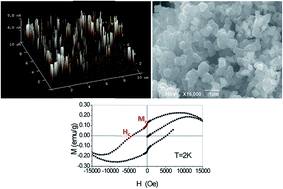In situ preparation and characterization of a conductive and magnetic nanocomposite of polypyrrole and copper hydroxychloride
Abstract
A nanocomposite of conductive polypyrrole and ferrimagnetic copper hydroxychloride (Cu2Cl(OH)3) was prepared in a single-step via in situ chemical oxidation of pyrrole using CuCl2 as an oxidizing agent. In this study, it was shown that by monitoring the reaction time and conditions, the physical and chemical properties of polypyrrole and Cu2Cl(OH)3 in the nanocomposite can be easily controlled. This resulted in a nanocomposite with optimized conductivity and magnetic properties for a wide variety of applications such as magnetic recording, electromagnetic shielding, sensors, and spintronic devices. The obtained conductivity (0.0006–33 S cm−1) and magnetization (10.25–53.39 emu mol−1) measurements of the nanocomposite were within the range suitable for these applications and were achieved by controlling the reaction conditions and thus the composition of the nanocomposite. With FTIR, XPS and UV-Vis spectroscopy, it was observed that as the reaction proceeds with time under controlled conditions, the oxidation of pyrrole in the presence of CuCl2 leads to significant structural changes in polypyrrole as well as gradual precipitation of Cu2Cl(OH)3. XRD and SEM analysis showed the effect of reaction conditions on the crystallinity and the morphology of the polypyrrole/Cu2Cl(OH)3 nanocomposite. While the chemical and structural variations in polypyrrole were correlated with the conductivity of the nanocomposite, measured via the conductive-AFM technique, the changes in magnetic properties of the nanocomposite were mainly attributed to the variations observed in the crystallinity of Cu2Cl(OH)3.


 Please wait while we load your content...
Please wait while we load your content...